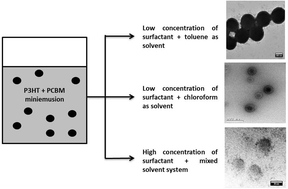Tuning the size and morphology of P3HT/PCBM composite nanoparticles: towards optimized water-processable organic solar cells
Abstract
The function of an organic solar cell relies on making a contact surface between a donor and acceptor material. For efficient conversion of solar energy, this heterojunction must be maximized. Nanoparticulate systems already have a large surface-to-volume ratio per se. We increase the area of the heterojunction even further. Based on the miniemulsion process, colloidal particles are produced that contain both donor and acceptor material. Composite nanoparticles of Poly(3-hexylthiophene-2,5-diyl) and Phenyl-C61-butyric acid methyl ester (P3HT : PCBM) are prepared via the miniemulsion method. Here, the process parameters are tuned to optimize the efficacy of the composite nanoparticles. Depending on the surfactant concentration, the solvent and the processing temperature, we can tune the particle size and the morphology of the intraparticular heterojunction from Janus type to core–shell structures. Based on these findings, we finally identify the process parameters to achieve optimal solar cell performance.



 Please wait while we load your content...
Please wait while we load your content...